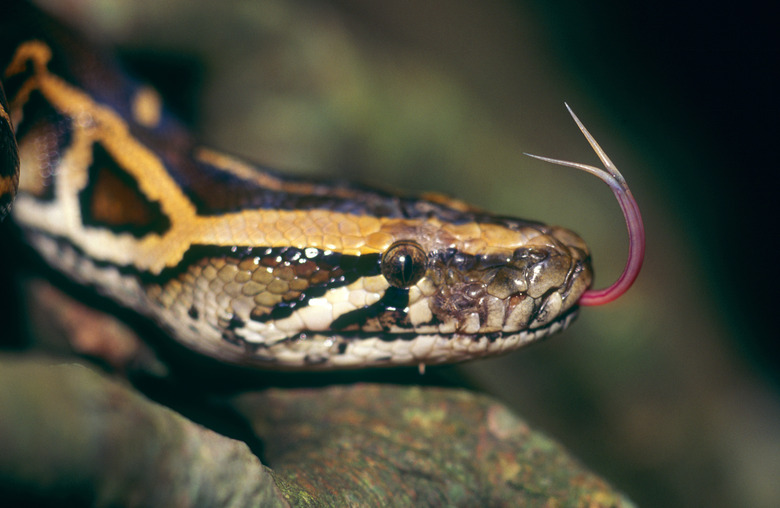How Do Snakes Mate?
As snakes emerge from hibernation, mating – not eating – is usually first on the menu, depending on the species. Snake sex can occur right after spring or continue throughout the summer into late fall, depending on the species. Some males fight for the right to have sex with the females, as with garter snakes for example. Some snakes mate multiple times a year, while others do not. Black rat snakes mate once every two to three years in cold climates and once a year in moderate ones. Snakes do not form mating bonds, and once copulation takes place, males and females go their separate ways.
TL;DR (Too Long; Didn't Read)
Snakes generally copulate the same way many other animals do – the male mounts the female – but they may remain entwined for several hours of mating before they separate and go their individual ways.
Snake Mating – Sometimes It's an Orgy
Snake Mating
–
Sometimes It's an Orgy
Pictures of snake mating lends credence to the idea that snake reproduction among certain species has all the makings of an orgy. Take for instance the common garter snake. During the spring, male garter snakes emerge from their dens en masse, writhing and wriggling in a swarm once the females awaken. Once one or more garter snake males copulate with the female and she becomes pregnant, a mating plug prevents other males from mating with her. At the same time her pheromones diminish, making her unattractive to males looking for a mate.
Snake Reproduction – the Act Itself
Snake Reproduction
–
the Act Itself
Snake genitalia is not on the exterior of their bodies as it hides inside a pocket near the base of the tail called the cloaca, which also houses their liquid and solid waste system. The male's genitalia – hemipenes – consists of two joined penises, with each penis affiliated with a single testicle, giving it a forked appearance. Male and female snakes become entangled during sex, wrapping around each other during the act. Once the snakes finish coitus, they go their separate ways. Among timber rattlesnakes, mating occurs from the middle of July through October, but females store the sperm through the summer into the end of fall, while their eggs form, until ovulation occurs the next spring.
Eggs or Live Birth
Eggs or Live Birth
Depending on the species, female snakes either lay eggs in a nest or hatch the eggs inside their own bodies and give birth to live young. Snake sex that results in live births occurs among venomous snakes like rattlesnakes, copperheads and cottonmouths, as well as among non-venomous snakes such as garter snakes and water snakes. Most female snakes look for a safe place to lay eggs, such as inside a rotting log or among leaf litter. The only female snake to actively build a nest is the king cobra. Oviparous refers to snakes that lay eggs outside their bodies, while viviparous indicates snakes that give birth to live young after incubating the eggs inside their bodies.
References
- Penn State: Black Rat Snake
- University of Missouri Extension: Snakes: Information for Missouri Homeowners
- University of Arizona: 5 Things to Know About Rattlesnakes and Their Babies
- Reed University: How Can You Cuddle Without Arms?
- University of Michigan: Crotalus Horridus
- Flagler College: King Cobra
Cite This Article
MLA
Brenner, Laurie. "How Do Snakes Mate?" sciencing.com, https://www.sciencing.com/snakes-mate-4568663/. 9 May 2019.
APA
Brenner, Laurie. (2019, May 9). How Do Snakes Mate?. sciencing.com. Retrieved from https://www.sciencing.com/snakes-mate-4568663/
Chicago
Brenner, Laurie. How Do Snakes Mate? last modified March 24, 2022. https://www.sciencing.com/snakes-mate-4568663/
